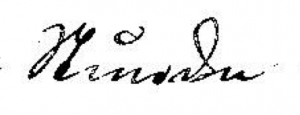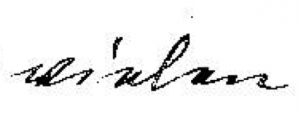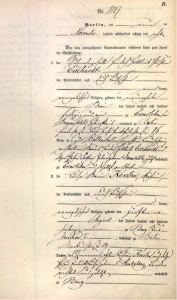Author’s Note: If you are interested in more tricks for deciphering old German handwriting, check out our popular book on the topic, or if you want to learn the handwriting yourself, sign up for our brand-new online course.
If you have ever delved into the exciting world of German family history, it is very likely that you have come across the elusive-yet-beautiful old German script. Almost like another language in itself, Kurrentschrift is a form of writing (based on late-medieval cursive) that was used in Germany and Austria until the mid-20th century. In my previous post, Ten Tips for Deciphering Old German Handwriting, I discussed ten basic steps for working with old German documents. While I still recommend hiring a professional for the best results (contact me here-I’d love to work with you), below are ten even more detailed tips to help you unlock the mystery of the old German script:
This post contains some affiliate links, which does not affect you at all, but does helps support my business as I earn a small amount from qualifying purchases as an Amazon associate. This in turn helps me to continue supporting you with educational (I hope!) genealogy content. That being said, I personally own – and personally love – anything I recommend, and hope that these resources help you as much as they have helped me. I couldn’t translate without them!
1. Get hip with the lingo. Letter writers of the past often used the same phrases over and over in writing, just as we do in English today (“Thank you for your e-mail”, “Attached please find”, etc.). Being familiar with these common phrases helps in transcribing the old handwriting, as it allows you to better recognize the rest of the sentence. Some phrases that you might find in historical German letters include:
| Ich habe deinen Brief erhalten/bekommen. | I received your letter. |
| Seid herzlich gegrüßt. | Literally: Be greeted affectionately.
English: We send you our warm regards. |
| Was Gott tut, das ist wohlgetan. | A German Saying: “What God does is well done” |
| Vielen herzlichen Dank. | Many warm/heartfelt thanks. |
| Wir sind alle gesund. | We are all healthy. |
As discussed in the first post, abbreviations also appear frequently in old German documents. The most common abbreviations include: “d.”, meaning “den” (the) before a date, as in “d. 2te February (the second of February), “u.” for “und” (and), and “geb.” for “geboren”, meaning “nèe.” The meanings of other abbreviations can be found using this site – although if you don’t speak German, have a dictionary handy!
2. Master the tiny details of the letters. In Ten Tips for Deciphering Old German Handwriting, I discussed the minute differences between “e”, “n” and “m”. Unfortunately, these aren’t the only letters in Kurrentschrift that look almost the same. Other examples include:
* “N” and “St” – These two letters are very similar and are often difficult for even a professional to tell apart. If you look closely, however, you can see that the bottoms of the two letters are (or should be) different. The “N” finishes with a swoop to the right, while the “St” finishes with the crossing of the “t” itself. However, in actual documents, this can still be difficult. The 1920s example of “St” in Stunde (hour) on the bottom also finishes with a swoop to the right and thus even more strongly resembles an N. Here, however, you can differentiate it from an “N” in the fact that the “t” is (slightly) crossed, as opposed to the “N” in “Nachmittag” (afternoon) above.
 |
 |
 |
 |
* “B”, “C” and “L” – If you look at the three capital letters below, you might be a little alarmed. They are incredibly similar. However, if you know the clues to look for, you will be able to tell them apart. The “C” (middle) is easy to differentiate from the other two letters as there is no loop at the top. Just a simple stroke with a little downward hook at the top right. As for the “B” (left) and the “L” (right), the “B” is different in that it has a little straight line coming off the bottom swoop, much like our lowercase cursive b today. Notice this line in the left word “Brief” (letter) compared to the rather fluid finishing of the “L” on the right in the word “Liebe” (dear). “C” is not a very common letter in German, and is often only found in names, such as “Christian.”

* “v” and “w” –These lowercase letters look similar, but are actually quite easy to tell apart. While they both have the loop on the right, the “v” only has one stroke before the loop, while the “w” has two. Below, “v” is on the left, with a real-life example of the word “vielen” (many). “w” is center, followed by an example of the word “wird” (will). Finally, the last column shows both letters in the words “verkauft werden” (will be sold). Notice how the “w” has one more stroke before the loop than the “v” in this sample from an 1868 letter.

|
  |
|
3. Understand the importance of occupations. As we are to some extent today, our ancestors were also defined by their occupations. Therefore, on any certificate, the occupation of a person was listed before the person’s name. For example, a certificate may read that “the farmer Johann Schmidt appeared before the undersigned registrar”, with farmer (Bauer) preceding the name of the person involved.
The level of one’s occupation was also important. Occupation levels were:
“Lehrling” – apprentice
“Geselle” – journeyman (apprenticeship complete)
“Meister” – master
These levels, if listed, always follow the name of the occupation. For example, “Schuhmachermeister” is a person who is a master shoemaker. In the examples below, Friedrich Gottlieb Christian Eckhardt was a Schuhmachergeselle (first handwritten word, top image) before he was a Schuhmachermeister (last handwritten word, top line of bottom image).

4. Think horse-drawn carriage driver. Speaking of occupations, many occupations that were around in the past are no longer around today. Or, if the occupation is still around today, there may have been a different word for it in the past. This website provides an A-Z list of old occupations with their modern-day German translation. If you don’t speak German, you can find the old-fashioned occupation of your ancestor in the left column, and then use a dictionary to translate one of the modern day names in the right column. In my experience, the most common occupation for women seems to have been “Näherin” (seamstress), while the most common occupation for men seems to have been “Bauer” (farmer). Edna M. Bentz’s book “If I Can, You Can Decipher German Records” has a great list of old-fashioned occupations as well.
5. Expect the unexpected. And by this, I mean that words may not be exactly as they are in the dictionary today. Just as our English speaking ancestors used words such as “thee” and “thou”, our German speaking ancestors used different words as well. If you transcribe a word and have absolutely no idea what it means, it could easily be a word no longer in use. This website offers a great German-German dictionary (started by the Grimm brothers) for old-fashioned German words.
But what if you still can’t find your word? In that case, if you are certain of your transcription, it very likely could be a spelling mistake on the part of the author. As German spelling did not become widely standardized until the end of the 19th century, words in letters and other documents were often spelled “creatively.” While this can make deciphering certain words rather difficult, it is slightly easier if you are aware of some of the more common mistakes. Below, some examples:
* a “t” might be substituted for a “d”
* a “g” might be substituted for a “k” or a “ch”
* an “f” could be substituted for a “v”
In the above example, the author of the letter writes “ich aich noch nigt” instead of the proper German spelling “ich euch noch nicht” (part of a sentence, literally “I haven’t…you yet.”) The “eu” is consistently replaced with “ai” in this letter and the “ch” with a “g”. Once you start to notice the common mistakes an author makes, you can identify these substitutions in other words in your document.
6. Keep on an eye on those Americans. If your German ancestors were in America, they might have included English words and place names in their letters. I’ve come across “Varmer” (farmer), “Kolorata” (Colorado), “daler” (dollar), “vor schur” (for sure), and so on. So, if you cannot recognize a German word, take a step back and ask yourself if your ancestor could have been using some of their newly learned English.
7. Be street smart. The word for street in German is “Straße”, often abbreviated “Str.” If you know that a word in your document is a street, but can’t figure out which street it is, use this website to help you out. You type your ancestor’s city in “Suche im Strassenverzeichnis”, which then pulls up a map of the city and an A-Z list of street names. If you know at least some of the letters in your street name, this can help you recognize the correct transcription of the word.
8. Don’t be fooled by “normal” script. Names of people were often written in normal Latin script, just as the cursive script we use today. It is important to be aware of this fact – for example, you don’t want to see a letter “e” in a name and think that that is how an “e” is written in the rest of the document. Much the opposite – names were often signed one way, while the body of the document was written in Kurrent. This is especially true for church book registers.
In the example below, the author signs her name (Louise H) in “normal” script. You can see that there is no swoop above the “u” as in Kurrent, the “e” at the end of Louise is more like our cursive “e” than the Kurrent “e” that resembles our modern “n” and the “H” is nothing like the complicated Kurrent “H” that goes both above and below the line. However, in the rest of this document, the author would have used the Kurrent letters.
9. Understand the system. If you know the information that should be on a document, transcribing is much easier. Luckily, certificates from most regions of Germany/Austria have similar formats, providing the same information for the people involved. Some information you can expect on birth, baptismal, marriage and death certificates include:
* City, date
* Person’s name, occupation, city of residency, religion
* How the person was identified (passport, baptismal certificate, military pass, birth certificate)
* Parents’ names, occupations, city of residency, religion, if they are deceased
* Witness’ names, occupations, city of residency, religion, age
* Signatures of those involved, witnesses and registrar
The First Page of a Marriage Certificate, Berlin 1888
10. And finally, and most importantly, know when to take a break. You’ve almost finished your transcription, but there is still one frustrating word that you cannot figure out for the life of you. You want to persevere and finish, but my advice is: don’t. Take a break, and things will often look much clearer if you stop and come back later. I’ve experienced this a number of times: The transcription is just about finished, but that one last word is baffling me. I take a break, come back later or even the next day, and all of the sudden, the word is perfectly clear and I wonder how I didn’t see it before. As a linguist and not a scientist, I can’t explain how that happens, but it amazes me every time!
And that’s that! With these ten tips, in addition to the original Ten Tips for Deciphering Old German Handwriting, you should be well on your way to battling the handwriting of the past. And once again, if you would like a professional to translate your documents, I’d be happy to help – contact me at language@germanologyunlocked.com.
Image Credit: All original samples have been published with the permission of the client.
All Kurrentschrift letter samples are from the Kurrentschrift wikipedia page, except for “N” and “St”, which can be found here.








2 Responses
This is wonderful! WOuld it be possible to link to this article from my own blog (“Shore to Shore”)? I wrote about a series of letters that my greatgrandfather Abel sent home, to the Rhineland area…Baerl/Binsheim. This information is very helpful and very well written. I do not speak German.
Hi Debra,
Glad you like it! Yes, please feel free to include a link to the article from your own blog. I would love to see your post as well if you would like to share it here.